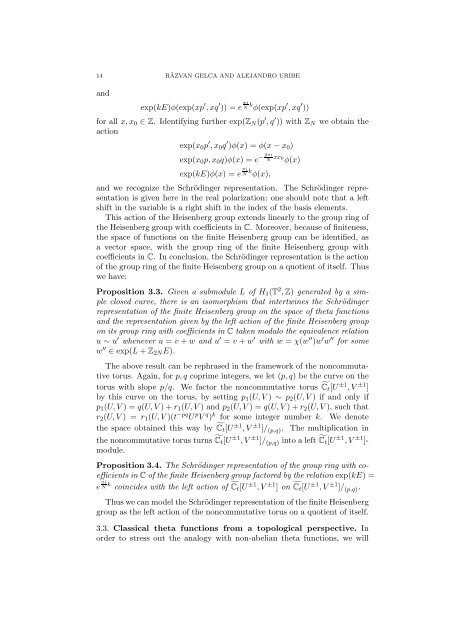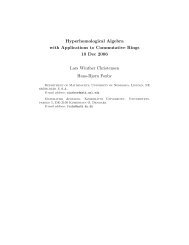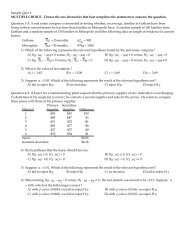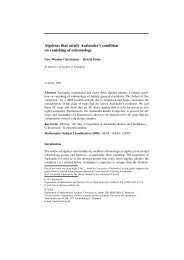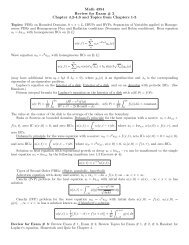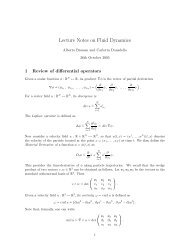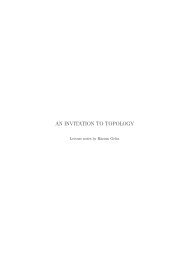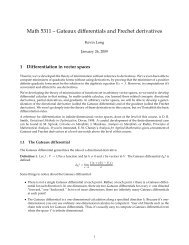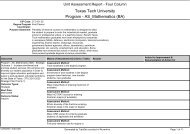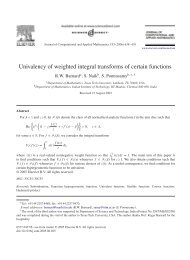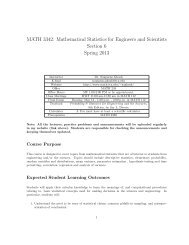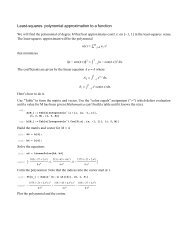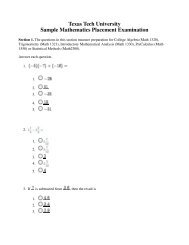QUANTUM MECHANICS AND NON-ABELIAN THETA FUNCTIONS ...
QUANTUM MECHANICS AND NON-ABELIAN THETA FUNCTIONS ...
QUANTUM MECHANICS AND NON-ABELIAN THETA FUNCTIONS ...
You also want an ePaper? Increase the reach of your titles
YUMPU automatically turns print PDFs into web optimized ePapers that Google loves.
14RĂZVAN GELCA <strong>AND</strong> ALEJ<strong>AND</strong>RO URIBEandexp(kE)φ(exp(xp ′ ,xq ′ )) = e πiN k φ(exp(xp ′ ,xq ′ ))for all x,x 0 ∈ Z. Identifying further exp(Z N (p ′ ,q ′ )) with Z N we obtain theactionexp(x 0 p ′ ,x 0 q ′ )φ(x) = φ(x − x 0 )exp(x 0 p,x 0 q)φ(x) = e −2πi N xx 0φ(x)exp(kE)φ(x) = e πiN k φ(x),and we recognize the Schrödinger representation. The Schrödinger representationis given here in the real polarization; one should note that a leftshift in the variable is a right shift in the index of the basis elements.This action of the Heisenberg group extends linearly to the group ring ofthe Heisenberg group with coefficients in C. Moreover, because of finiteness,the space of functions on the finite Heisenberg group can be identified, asa vector space, with the group ring of the finite Heisenberg group withcoefficients in C. In conclusion, the Schrödinger representation is the actionof the group ring of the finite Heisenberg group on a quotient of itself. Thuswe have:Proposition 3.3. Given a submodule L of H 1 (T 2 , Z) generated by a simpleclosed curve, there is an isomorphism that intertwines the Schrödingerrepresentation of the finite Heisenberg group on the space of theta functionsand the representation given by the left action of the finite Heisenberg groupon its group ring with coefficients in C taken modulo the equivalence relationu ∼ u ′ whenever u = v + w and u ′ = v + w ′ with w = χ(w ′′ )w ′ w ′′ for somew ′′ ∈ exp(L + Z 2N E).The above result can be rephrased in the framework of the noncommutativetorus. Again, for p,q coprime integers, we let (p,q) be the curve on thetorus with slope p/q. We factor the noncommutative torus ˜C t [U ±1 ,V ±1 ]by this curve on the torus, by setting p 1 (U,V ) ∼ p 2 (U,V ) if and only ifp 1 (U,V ) = q(U,V ) + r 1 (U,V ) and p 2 (U,V ) = q(U,V ) + r 2 (U,V ), such thatr 2 (U,V ) = r 1 (U,V )(t −pq U p V q ) k for some integer number k. We denotethe space obtained this way by ˜C t [U ±1 ,V ±1 ]/ (p,q) . The multiplication inthe noncommutative torus turns ˜C t [U ±1 ,V ±1 ]/ (p,q) into a left ˜C t [U ±1 ,V ±1 ]-module.Proposition 3.4. The Schrödinger representation of the group ring with coefficientsin C of the finite Heisenberg group factored by the relation exp(kE) =e πiN k coincides with the left action of ˜C t [U ±1 ,V ±1 ] on ˜C t [U ±1 ,V ±1 ]/ (p,q) .Thus we can model the Schrödinger representation of the finite Heisenberggroup as the left action of the noncommutative torus on a quotient of itself.3.3. Classical theta functions from a topological perspective. Inorder to stress out the analogy with non-abelian theta functions, we will


